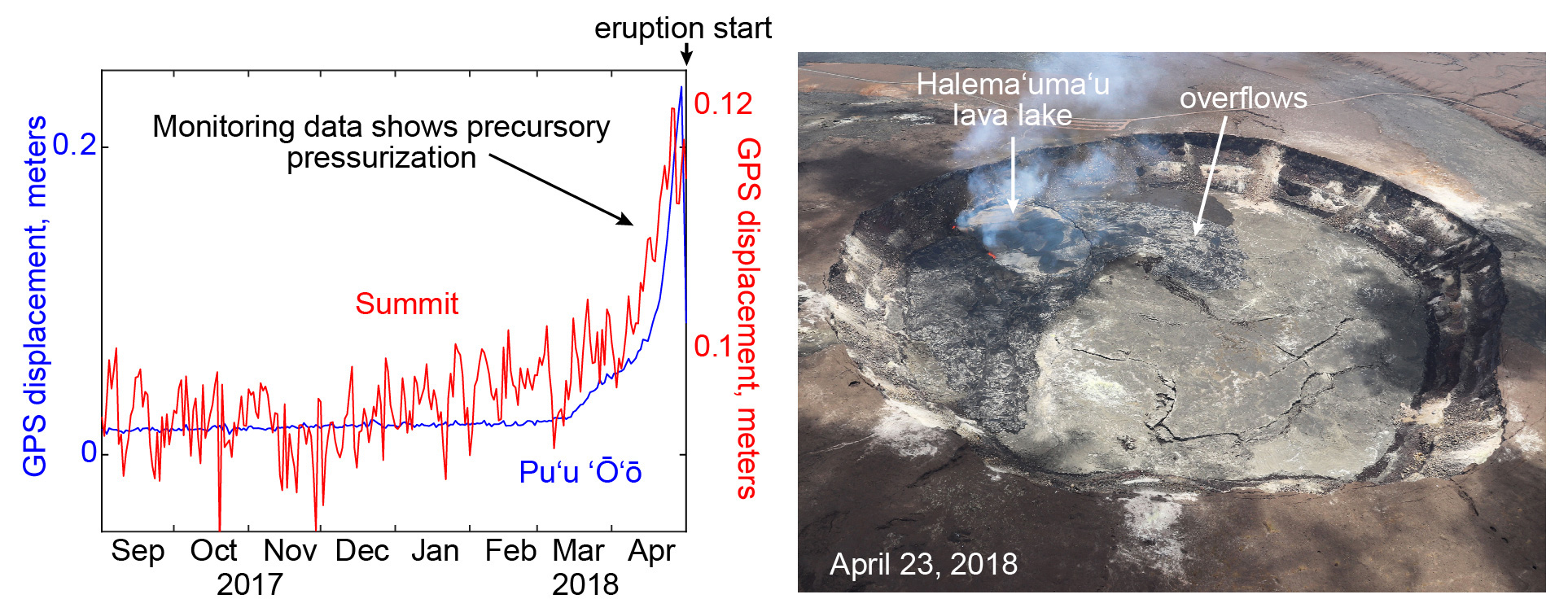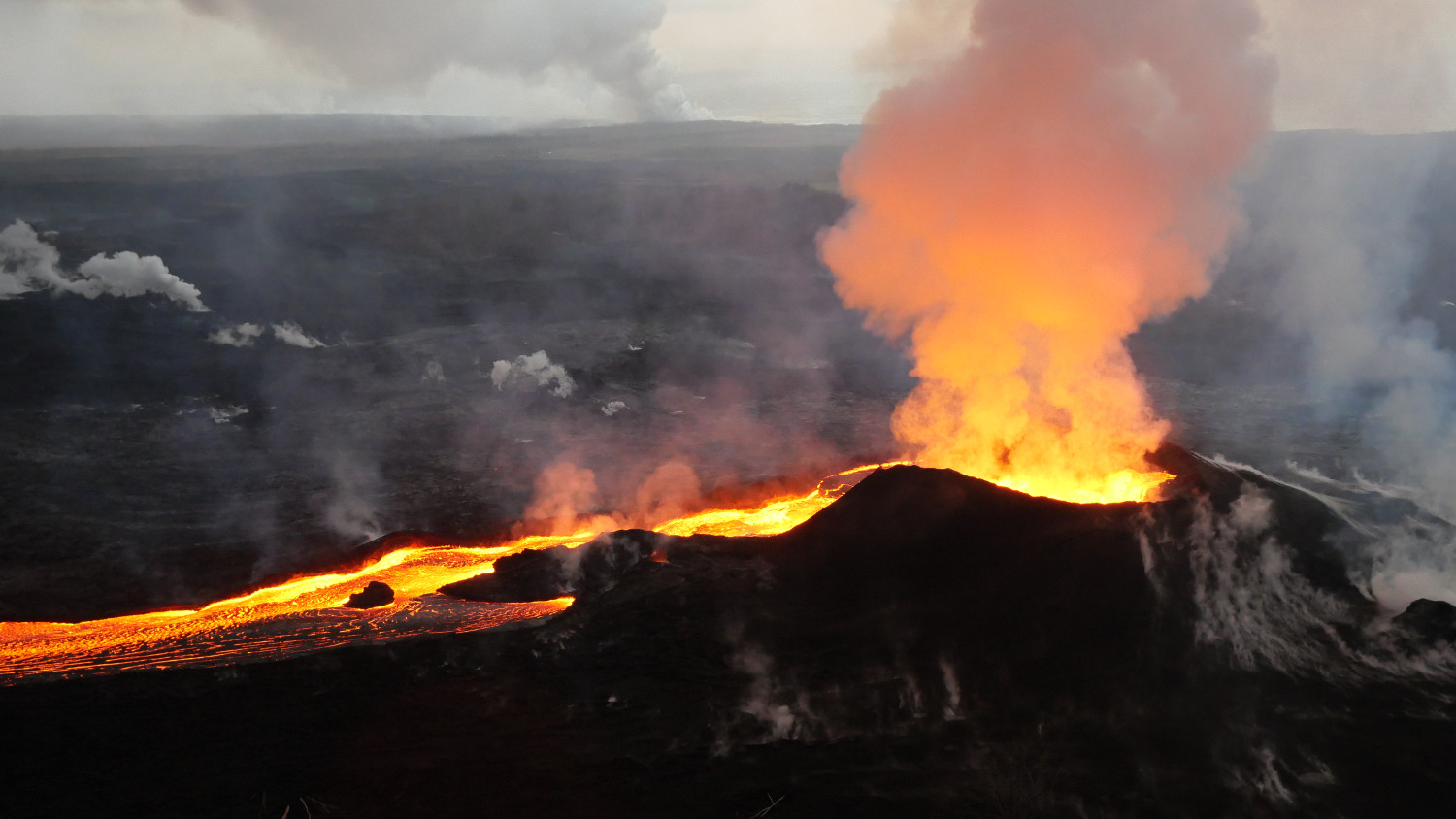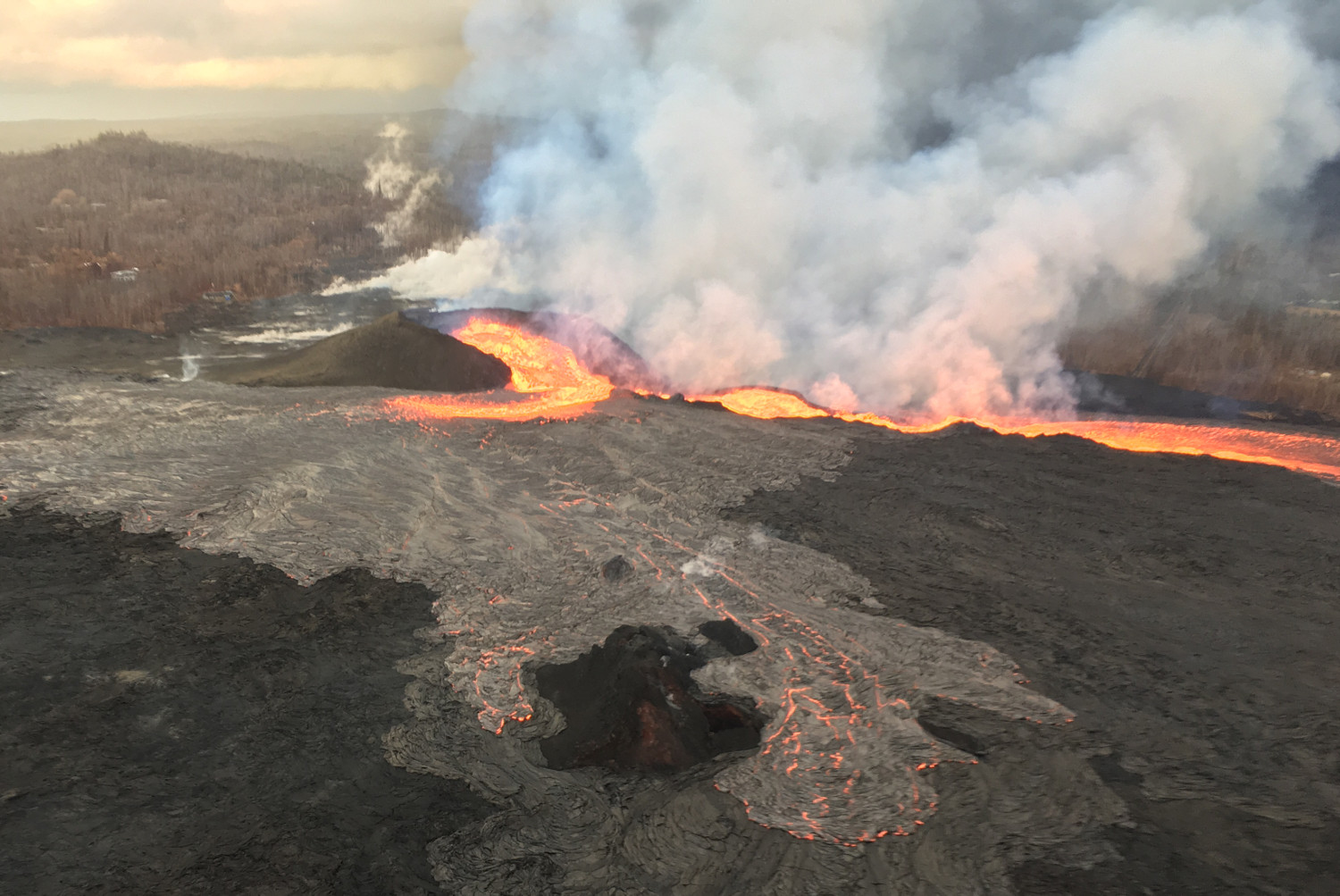(BIVN) – Hawaiʻi island residents are still trying to recover from the 2018 eruption of Kīlauea volcano, and almost two years after the start of the dramatic event, scientists are still debating what triggered the final episode of the volcano’s 35-year long eruption.
One recent study, published in Nature, points to heavy rainfall.
From the study’s abstract:
The event was preceded by several months of anomalously high precipitation. It has been proposed that rainfall can modulate shallow volcanic activity, but it remains unknown whether it can have impacts at the greater depths associated with magma transport. Here we show that immediately before and during the eruption, infiltration of rainfall into Kīlauea Volcano’s subsurface increased pore pressure at depths of 1 to 3 kilometres by 0.1 to 1 kilopascals, to its highest pressure in almost 50 years. We propose that weakening and mechanical failure of the edifice was driven by changes in pore pressure within the rift zone, prompting opportunistic dyke intrusion and ultimately facilitating the eruption.
Authors Jamie Farquharson and Falk Amelung go further, saying, “a precipitation-induced eruption trigger is consistent with the lack of precursory summit inflation, showing that this intrusion — unlike others — was not caused by the forceful intrusion of new magma into the rift zone.”
Big Island Video News, however, was among the local media to note inflation at the summit and on the East Rift Zone prior to the 2018 eruption. The USGS Hawaiian Volcano Observatory began publishing new Volcanic Activity Notices about the ongoing inflation weeks ahead of the event.

Plot of ground motion as recorded by a GPS station at Kīlauea’s summit (red) and the Puʻu ʻŌʻō vent (blue) for the 8 months leading up to the 2018 eruption. Note the sharp increase indicating pressurization beginning in March. Image shows an aerial view of Halemaumau crater and the actively overflowing lava lake on April 23, 2018. USGS Photo.
In this week’s Volcano Watch article, the USGS HVO says increasing magma pressure was most likely the culprit in triggering the 2018 Kīlauea eruption. They wrote:
Understanding the immediate causes of volcanic eruptions is necessary for timely warnings. The topic, therefore, is of great interest to volcanologists, and each eruption offers an opportunity to add insight.
This week, many of us read news coverage of a recent study suggesting that unusually heavy rainfall triggered the 2018 eruption of Kīlauea. To address possible heightened concern about this correlation, this week’s Volcano Watch offers comments based on HVO’s collective scientific understanding of Kīlauea. Meanwhile, HVO and USGS colleagues are preparing a formal response for publication in the scientific literature.
This hypothesis about heavy rainfall is thought-provoking, but does it mean that Hawaiʻi residents need to be concerned that heavy rain might cause the next eruption?
Based on HVO’s analysis of data collected in 2018, plus many studies of previous eruptions, our answer is that no, residents need not be concerned about a connection.
Our analysis indicates that increasing pressure in the magmatic system, which far exceeds the change in pressure modeled as due to rainwater infiltration, was the primary driver in triggering the 2018 eruption.
For HVO, the smoking gun is found in the ground deformation record across a broad region of Kīlauea Volcano leading up to the eruption.
Specifically, tiltmeter and GPS stations recorded rapid uplift of the ground surface, best explained as the result of increasing pressure within the magmatic plumbing system at Puʻu ʻŌʻō, starting in March 2018. Rapid uplift began at the summit of Kīlauea a few weeks later as the summit reservoir began inflating. This pressurization was widespread and drove lava lakes at Puʻu ʻŌʻō and the summit to unusually high levels, causing the largest overflows in Halemaʻumaʻu during the entire 10-year lifespan of the lava lake.
These changes were so clear that HVO issued a Volcano Activity Notice on April 17, 2018, noting ongoing pressurization, and forecasting that a new eruptive vent could form on the East Rift Zone.
On April 30, there was a small outbreak of lava on the flank of Puʻu ʻŌʻō. Magma then drained from within the shallow Puʻu ʻŌʻō system, the summit of Puʻu ʻŌʻō collapsed, and magma moved forcefully down the core of the rift zone toward Leilani Estates. This intrusion continued for several days, driven by magmatic pressure within the rift zone, ultimately erupting on May 3.
In summary, our consensus interpretation of HVO’s monitoring data is that magma pressurization was the driving force in triggering the events of late April and early May of 2018.
No external process, such as rainfall, is needed to explain this.
But what about the rainfall hypothesis? While the role of groundwater and rain infiltration impacting the behavior of the volcano remains an interesting area of research, we know that extreme rainfall events have occurred many times in the recent past when no eruptions occurred, and the spring 2018 rains were no greater than many previous rainstorms.
Science demands that one pose a question, gather observations, develop a hypothesis, and test the idea against available data and models. It is not uncommon for scientists to have conflicting ideas about the interpretation of data. In fact, vigorous debate over interpretations and the validity of conclusions is the hallmark of the scientific process, an expected part of the scientific method and search for the truth.
Kīlauea’s 2018 eruption was remarkable and, sadly, very destructive, but the cause seems to have followed the pattern of many previous eruptions – rising magma pressure reached a critical threshold, and magma could no longer be contained. And, while the complexity of Kīlauea’s magma system makes predicting the timing and size of eruptions difficult, understanding the signs and effects of changing magmatic pressure is the most promising avenue toward forecasting future events.
The Nature article now contains a comment from co-author Farquharson, acknowledging the recent statements from the USGS. He wrote:
In this article, there is a misstatement regarding the precursory summit inflation: we state “consistent with the lack of precursory summit inflation”; however, there was a small amount (2–3 cm) of localised summit inflation detected with GPS prior to the eruption. In addition, our usage of the 1924 eruption start date rather than the date of precursory activity means that our statement that “historical precipitation records show that Kīlauea’s May 1924 eruption … also followed extremely wet conditions,” is incorrect. Precursory activity was reported in February of that year, preceding the elevated rainfall in April. We note also that in Figures 2c and 2e, rainfall is mistakenly reported in units of m rather than mm. The distribution statistics of these data remain the same. A formal author correction will be forthcoming.
We thank the efforts of Mike Poland and other USGS personnel for bringing this to our attention.



by Big Island Video News8:32 am
on at
STORY SUMMARY
HAWAIʻI ISLAND - Was the 2018 eruption of Kīlauea volcano caused by heavy rainfall? Scientists on the island say there was another, more likely cause.